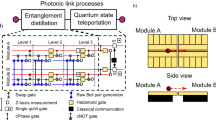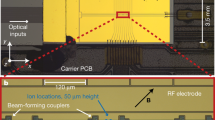Abstract
Among the numerous types of architecture being explored for quantum computers are systems utilizing ion traps, in which quantum bits (qubits) are formed from the electronic states of trapped ions and coupled through the Coulomb interaction. Although the elementary requirements for quantum computation have been demonstrated in this system, there exist theoretical and technical obstacles to scaling up the approach to large numbers of qubits. Therefore, recent efforts have been concentrated on using quantum communication to link a number of small ion-trap quantum systems. Developing the array-based approach, we show how to achieve massively parallel gate operation in a large-scale quantum computer, based on techniques already demonstrated for manipulating small quantum registers. The use of decoherence-free subspaces significantly reduces decoherence during ion transport, and removes the requirement of clock synchronization between the interaction regions.
This is a preview of subscription content, access via your institution
Access options
Subscribe to this journal
Receive 51 print issues and online access
$199.00 per year
only $3.90 per issue
Buy this article
- Purchase on Springer Link
- Instant access to full article PDF
Prices may be subject to local taxes which are calculated during checkout


Similar content being viewed by others
References
Shor, P. W. in Proc. 35th Annu. Symp. on the Foundations of Computer Science (ed. Goldwasser, S.) 124–134 (IEEE Computer Society, Los Alamitos, 1994)
Grover, L. K. Quantum mechanics helps in searching for a needle in a haystack. Phys. Rev. Lett. 79, 325–328 (1997)
Cirac, J. I. & Zoller, P. Quantum computations with cold trapped ions. Phys. Rev. Lett. 74, 4091–4094 (1995)
DiVincenzo, D. P. in Scalable Quantum Computers (eds Braunstein, S. L. & Lo, H. K.) 1–14 (Wiley-VCH, Berlin, 2001)
Monroe, C. et al. Resolved-sideband Raman cooling of a bound atom to the 3D zero-point energy. Phys. Rev. Lett. 75, 4011–4014 (1995)
King, B. E. et al. Cooling the collective motion of trapped ions to initialize a quantum register. Phys. Rev. Lett. 81, 1525–1528 (1998)
Roos, C. et al. Quantum state engineering on an optical transition and decoherence in a Paul trap. Phys. Rev. Lett. 83, 4713–4716 (1999)
Monroe, C., Meekhof, D. M., King, B. E., Itano, W. M. & Wineland, D. J. Demonstration of a fundamental quantum logic gate. Phys. Rev. Lett. 75, 4714–4717 (1995)
Sackett, C. A. et al. Experimental entanglement of four particles. Nature 404, 256–259 (2000)
Nägerl, H. C. et al. Laser addressing of individual ions in a linear ion trap. Phys. Rev. A 60, 145–148 (1999)
Blatt, R. & Zoller, P. Quantum jumps in atomic systems. Eur. J. Phys. 9, 250–256 (1988)
Rowe, M. A. et al. Experimental violation of a Bell's inequality with efficient detection. Nature 409, 791–794 (2001)
Wineland, D. J. et al. Experimental issues in coherent quantum-state manipulation of trapped atomic ions. J. Res. NIST 103, 259–328 (1998)
Hughes, R. J., James, D. F. V., Knill, E. H., Laflamme, R. & Petschek, A. G. Decoherence bounds on quantum computation with trapped ions. Phys. Rev. Lett. 77, 3240–3243 (1996)
Enzer, D. G. et al. in Experimental Implementation of Quantum Computation '01 (ed. Clark, R.) (Rinton, Princeton, 2001)
Pellizzari, T., Gardiner, S. A., Cirac, J. I. & Zoller, P. Decoherence, continuous observation, and quantum computing: A cavity QED model. Phys. Rev. Lett. 75, 3788–3791 (1995)
DeVoe, R. G. Elliptical ion traps and trap arrays for quantum computation. Phys. Rev. A 58, 910–914 (1998)
Steane, A. M. & Lucas, D. M. Quantum computing with trapped ions, atoms and light. Fortsch. Phys. 48, 839–858 (2000)
Cirac, J. I. & Zoller, P. A scalable quantum computer with ions in an array of microtraps. Nature 404, 579–581 (2000)
Steane, A. et al. Speed of ion-trap quantum-information processors. Phys. Rev. A 62, 042305 (2000)
Sørensen, A. & Mølmer, K. Entanglement and quantum computation with ions in thermal motion. Phys. Rev. A 62, 022311 (2000)
Paul, W. Electromagnetic traps for charged and neutral particles. Rev. Mod. Phys. 62, 531–540 (1990)
Turchette, Q. A. et al. Heating of trapped ions from the quantum ground state. Phys. Rev. A 61, 063418 (2000)
Kielpinski, D. . Entanglement and Decoherence in a Trapped-ion Quantum Register. Thesis, Univ. Colorado (2001); available at 〈http://www.boulder.nist.gov/timefreq/ion/qucomp/papers.htm〉
Rowe, M. A. et al. Transport of quantum states and separation of ions in a dual RF ion trap. Preprint quant-ph/0205094 at 〈http://xxx.lanl.gov〉 (2002).
Guthöhrlein, G. R., Keller, M., Hayasaka, K., Lange, W. & Walther, H. A single ion as a nanoscopic probe of an optical field. Nature 414, 49–51 (2001)
Kielpinski, D. et al. Sympathetic cooling of trapped ions for quantum logic. Phys. Rev. A 61, 032310 (2000)
Morigi, G. & Walther, H. Two-species Coulomb chains for quantum information. Eur. Phys. J. D 13, 261–269 (2001)
Larson, D. J., Bergquist, J. C., Bollinger, J. J., Itano, W. M. & Wineland, D. J. Sympathetic cooling of trapped ions: A laser-cooled two-species nonneutral ion plasma. Phys. Rev. Lett. 57, 70–73 (1986)
Rohde, H. et al. Sympathetic ground-state cooling and coherent manipulation with two-ion crystals. J. Opt. B 3, S34–S41 (2001)
Blinov, B. B. et al. Sympathetic cooling of trapped Cd+ isotopes. Preprint quant-ph/0112084 at 〈http://xxx.lanl.gov〉 (2001).
Lidar, D. A., Chuang, I. L. & Whaley, K. B. Decoherence-free subspaces for quantum computation. Phys. Rev. Lett. 81, 2594–2597 (1998)
Duan, L. M. & Guo, G. C. Reducing decoherence in quantum-computer memory with all quantum bits coupling to the same environment. Phys. Rev. A 57, 737–741 (1998)
Kielpinski, D. et al. A decoherence-free quantum memory using trapped ions. Science 291, 1013–1015 (2001)
Sørensen, A. & Mølmer, K. Quantum computation with ions in thermal motion. Phys. Rev. Lett. 82, 1971–1974 (1999)
van Enk, S. J. The physical meaning of phase and its importance for quantum teleportation. J. Mod. Opt. 48, 2049–2054 (2001)
Steane, A. The ion-trap quantum information processor. Appl. Phys. B 64, 623–643 (1997)
Young, B. C., Cruz, F. C., Itano, W. M. & Bergquist, J. C. Visible lasers with subhertz linewidths. Phys. Rev. Lett. 82, 3799–3802 (1999)
Nielsen, M. A. & Chuang, I. L. Quantum Computation and Quantum Information 425–493 (Cambridge Univ. Press, Cambridge, 2000)
Acknowledgements
We acknowledge the experimental contributions of the NIST Ion Storage group, and also J. Beall for assistance with microfabrication. We thank D. Leibfried and M.A. Rowe for comments on the manuscript. D.K. and D.J.W. were supported by the US National Security Agency (NSA), Advanced Research and Development Activity (ARDA) and the Office of Naval Research. C.M. was supported by the US NSA, ARDA and the National Science Foundation ITR programme.
Author information
Authors and Affiliations
Corresponding author
Rights and permissions
About this article
Cite this article
Kielpinski, D., Monroe, C. & Wineland, D. Architecture for a large-scale ion-trap quantum computer. Nature 417, 709–711 (2002). https://doi.org/10.1038/nature00784
Issue Date:
DOI: https://doi.org/10.1038/nature00784
This article is cited by
-
Realization of a crosstalk-avoided quantum network node using dual-type qubits of the same ion species
Nature Communications (2024)
-
Quantum entanglement of ions for light dark matter detection
Journal of High Energy Physics (2024)
-
Interactive cryptographic proofs of quantumness using mid-circuit measurements
Nature Physics (2023)
-
Progress in quantum teleportation
Nature Reviews Physics (2023)
-
A high-fidelity quantum matter-link between ion-trap microchip modules
Nature Communications (2023)
Comments
By submitting a comment you agree to abide by our Terms and Community Guidelines. If you find something abusive or that does not comply with our terms or guidelines please flag it as inappropriate.



